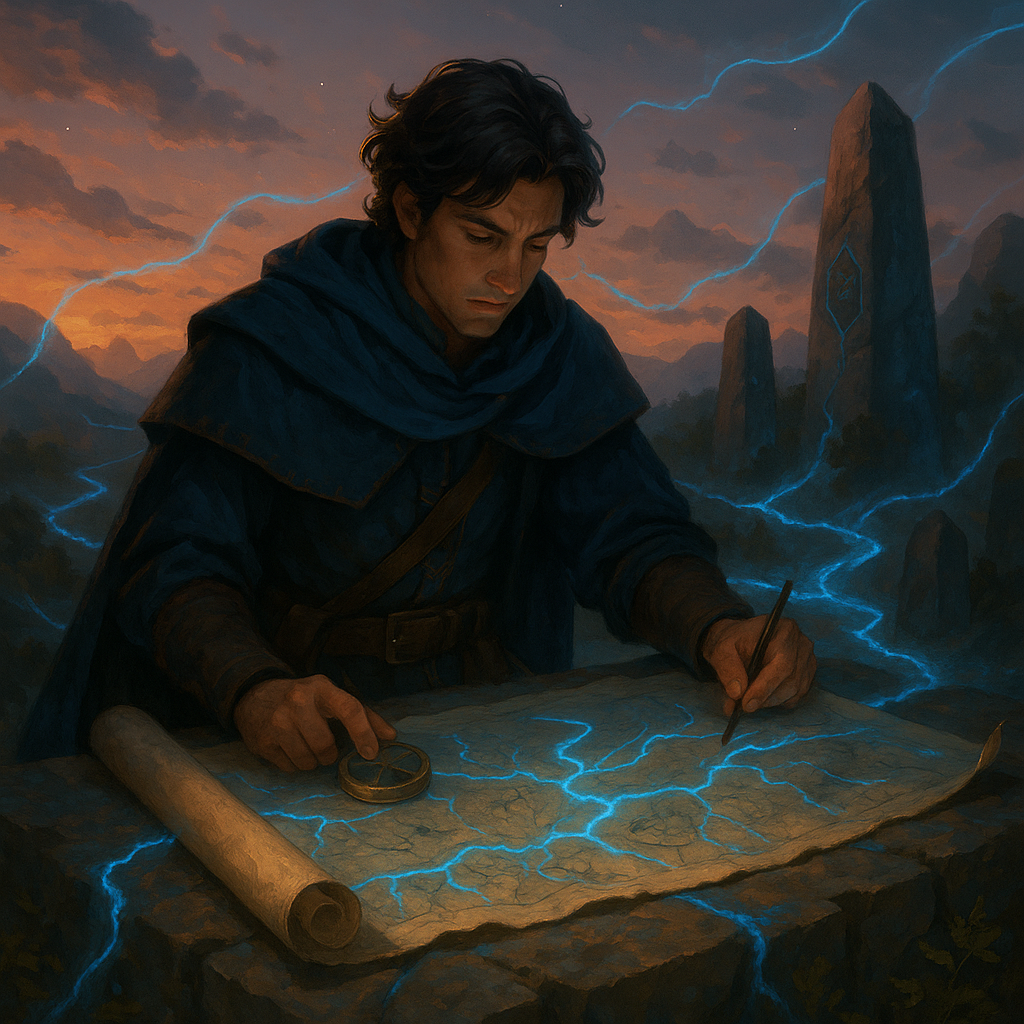Leyline Cartographer
Across Tanaria, the network of arcane leylines pulses beneath the land, unseen but deeply felt by those attuned to magic. Mapping these currents is the work of Leyline Cartographers—a profession few dare to attempt. These individuals chart magical routes that shift with time, storms, and arcane interference, creating maps that are invaluable to mages, kingdoms.
Becoming a Leyline Cartographer is no simple path. It requires both an extraordinary magical sense and a scientific mind, capable of enduring long expeditions through dangerous terrain, magical anomalies, and hostile territories. Apprentices must learn to read the subtle signs of a leyline—plants that glow faintly under moonlight, the hum of stones at dawn, the way animals avoid certain paths. The job demands not just study, but survival; many aspirants vanish in the wilds, consumed by magical storms or pulled into unstable rifts.
Those who succeed are celebrated. Their maps sell for fortunes, granting safe passage through magically volatile lands or leading explorers to hidden wells of power. A single completed leyline chart can change the fate of a kingdom, making these rare individuals both revered and hunted. Every mage dreams of walking in their footsteps, but only a handful ever see the world as they do—threaded with light only they can truly follow.
Career
Qualifications
A Leyline Cartographer needs both the mind of a scholar and the instincts of an adventurer. Only those who excel in arcane mastery, fieldcraft, and resilience can survive the profession, let alone thrive in it. Becoming a Leyline Cartographer is not just a matter of study—it’s a brutal combination of intellect, magical attunement, and survival skill. The profession demands qualifications far beyond what most can achieve:
Arcane Education:
Prospective cartographers must first study at a magical academy or under a master geomancer, learning the theory of leyline flow, planar anomalies, and arcane resonance. Most specialize in disciplines like divination, geomancy, or astral navigation. This stage can take 10–15 years of rigorous academic work.Apprenticeship:
Book knowledge alone is useless without field training. Apprentices spend years shadowing an established Cartographer, learning how to detect leyline currents in the wild. They practice with arcane instruments—compasses, resonance crystals, and spell-threaded charts—while traveling through dangerous terrain. Many apprentices fail or quit during this stage.Magical Attunement:
A crucial requirement is developing a personal “ley-sense”—the innate ability to feel the subtle hum of magical energy. This isn’t taught; it’s awakened through meditative rituals and exposure to high-concentration ley points. Those who cannot attune never advance.Survival Proficiency:
Mapping leylines means venturing into places untouched by civilization: wild forests, cursed ruins, deserts where reality bends. Aspirants must master wilderness survival, navigation, and warding against magical threats. Many undergo training similar to that of elite scouts or rangers.The Convergence Trial:
Before earning the title, candidates must survive a solo expedition to a leyline convergence and successfully record its flow without outside assistance. These locations are unstable and highly dangerous—one wrong step, and they may be consumed by arcane surges or dimensional rifts.Payment & Reimbursement
Leyline Cartographers are so rare that their services are considered invaluable. Accurate ley maps can alter trade routes, military strategies, and magical research, making their work highly sought after.
- Royal and Guild Commissions: Kingdoms, mage guilds, and wealthy patrons pay extraordinary sums to hire a Cartographer. A single detailed map of a leyline network can fetch thousands of gold crowns, with bonuses for accuracy and the discovery of new nodes.
- Exclusive Rights: Many contracts grant clients exclusive access to a cartographer’s findings, often leading to lifetime stipends or noble patronage.
- Artifact Trade: In regions where coin is secondary, Cartographers may be compensated with rare magical components, relics, or arcane tomes.
- Travel Expenses: Clients cover mounts, airship transport, protective wards, and provisions.
- Arcane Equipment: Specialized instruments—such as resonance crystals, mapping lenses, and containment charms—are expensive, and clients are expected to fund replacements if damaged.
- Hazard Pay: Dangerous assignments involving unstable zones or planar rifts multiply the base rate significantly.
- Compensation for Loss: If a Cartographer dies on assignment, their family is entitled to a portion of the contract value, enforced by the Cartographers’ Guild where applicable.
Perception
Purpose
Leyline Cartographers occupy a unique niche in any society they work with, fulfilling several overlapping roles:
Explorers of the Unknown: They push into uncharted regions where magic behaves unpredictably, extending the boundaries of known maps and uncovering sites of power.
Magical Infrastructure Experts: Their charts allow cities, guilds, and kingdoms to build wards, teleportation circles, and magical conduits with precision, preventing disasters caused by unstable ley currents.
Strategic Assets: In times of conflict, they provide maps of leylines that can be weaponized—used to disrupt enemy magic or amplify their own. This makes them highly valuable to military strategists.
Keepers of Knowledge: Beyond practical use, they preserve ancient understanding of the world’s magical veins, often becoming walking archives of arcane geography and history.
Bridges Between Worlds: Their work occasionally uncovers planar rifts or forgotten nodes of divine energy, making them intermediaries between the mundane world and higher powers.
In societies that rely heavily on magic, Leyline Cartographers are seen almost like engineers of the arcane landscape, shaping how magic flows through cities and fields. In less magically inclined cultures, they are regarded as eccentric adventurers or mystical savants—respected, but distant from everyday life.






A most valuable profession, one that certainly would seem to have great prestige, responsibility and perhaps also power. Though they may be sought or hunted, I would also suspect some wield power themselves, their ability, skill set and talent giving them great leverage that those with the savvy and know how turn into quite the asset to wield. Particularly perhaps those truly rare individuals who are both potent and skilled mages in their own right, combined with this skill set. I would have to imagine the sheer power such an individual commands and wields within society, the socio-political might they might be able to leverage would be quite noticeable.
Oh for sure! you hit the nail on the head.
"Every story is a thread, and together we weave worlds."
The Origin of Tanaria